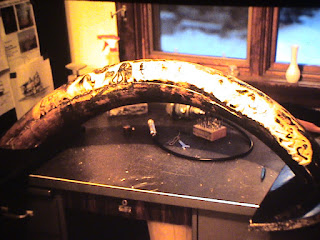This model of the ice Cutter Bear commissioned by the late Mel Quakenbush
of Fairbanks, Alaska was constructed mostly of mammoth or mastodon ivory.
The planks above the waterline are walrus ivory and the masts and booms
are whale bone. The black cap rail and anchors are made from baleen
from the mouth of a whale. It is mounted on a slab of jade from
the Kobuk mountains in northwestern Alaska. It measures about 20 inches
long. This famous ship built in Scotland (1874) was used for seal hunting
but the U.S. government bought it to rescue the Greely Expedition which
was stranded without supplies in the arctic. Mr. Quakenbush brought
Dale Brown blueprints from the Smithsonian as a guide in about 1981.
This is a piece of ivory from a Mastodon tusk found in Alaska.
The artwork was scrimshawed by Dale 1998
The bears are made of Alaskan soapstone
The bears are made of Alaskan soapstone
This piece about four inches tall was on a piece of
Mastodon ivory as well. Many large pieces like
the one below are found every summer in Alaska by
miners and earth-moving projects for road construction etc.
Dale Brown carved a prehistoric scene on this large
Mammoth tusk in about 1982 for Mel Quakenbush of Fairbanks.
The scrimshawed piece below was done on either Mastodon
or Woolly Mammoth in 1981. Scientists claim both species disappeared about
10,000 years ago, yet there are cave drawings of them proving that
man existed during that time. The difference between the two can
be seen in their teeth. Mastodon had teeth more designed for
wooded areas whereas the Woolly Mammoth had teeth used
more for grazing like in open plains.
http://www.bradshawfoundation.com/france/rouffignac/index.php
The difference between walrus ivory and elephant is easily identified. Elephants, both ancient and modern, have a herring bone pattern that can be seen in a cross cut section. Walrus like the lower piece in this picture has no such pattern.







